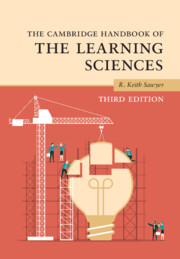Book contents
- The Cambridge Handbook of the Learning Sciences
- The Cambridge Handbook of the Learning Sciences
- Copyright page
- Contents
- Figures
- Tables
- Contributors
- Preface
- 1 An Introduction to the Learning Sciences
- Part I Foundations
- Part II Methodologies
- Part III Grounding Technology in the Learning Sciences
- Part IV Learning Together
- Part V Learning Disciplinary Knowledge
- Part VI Moving Learning Sciences Research into the Classroom
- 29 Learning as a Cultural Process
- 30 Designing for Meaningful Learning
- 31 Advances in Teacher Learning Research in the Learning Sciences
- 32 Learning Sciences and Policy
- 33 The Learning Sciences in the 2020s: Implications for Schools and Beyond
- Index
- References
30 - Designing for Meaningful Learning
Interest, Motivation, and Engagement
from Part VI - Moving Learning Sciences Research into the Classroom
Published online by Cambridge University Press: 14 March 2022
- The Cambridge Handbook of the Learning Sciences
- The Cambridge Handbook of the Learning Sciences
- Copyright page
- Contents
- Figures
- Tables
- Contributors
- Preface
- 1 An Introduction to the Learning Sciences
- Part I Foundations
- Part II Methodologies
- Part III Grounding Technology in the Learning Sciences
- Part IV Learning Together
- Part V Learning Disciplinary Knowledge
- Part VI Moving Learning Sciences Research into the Classroom
- 29 Learning as a Cultural Process
- 30 Designing for Meaningful Learning
- 31 Advances in Teacher Learning Research in the Learning Sciences
- 32 Learning Sciences and Policy
- 33 The Learning Sciences in the 2020s: Implications for Schools and Beyond
- Index
- References
Summary
Understanding individuals’ interest, motivation, and engagement is essential to designing for meaningful learning. We typically think of engaged learners as those who have a more developed interest in content (e.g., math, robotics, swimming) and are motivated to learn. But learners who are not engaged or who are unmotivated can also be assisted to meaningfully engage with content in ways that lead to deep learning. This chapter summarizes research on two questions for how to design for meaningful learning: What supports unmotivated individuals to become motivated to learn? How do we design tasks that enable those who are already engaged to continue to deepen their interest? The chapter summarizes five research studies that provide converging evidence that designing for meaningful learning requires (1) addressing the differences in learners’ interest, motivation, and engagement; (2) supporting learners in engaging in thinking about content with others. Learning environments can be designed to enable all learners, regardless of their initial engagement with material, to develop meaningful connections to content, thus optimizing their learning.
Keywords
- Type
- Chapter
- Information
- The Cambridge Handbook of the Learning Sciences , pp. 602 - 618Publisher: Cambridge University PressPrint publication year: 2022



